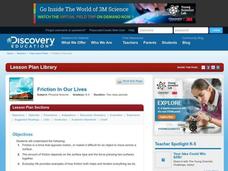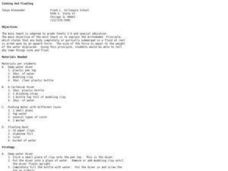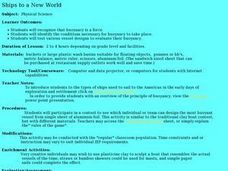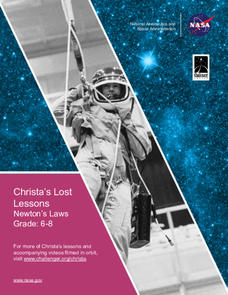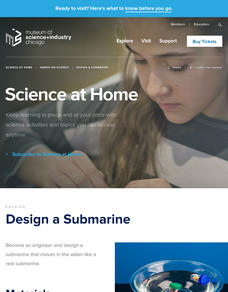Cornell University
Friction
Friction and gravity are always at odds! Learners complete a set of activities to explore the relationship between friction and gravity. Groups make conclusions about the factors that affect the amount and type of friction between surfaces.
DiscoverE
Human Arch
Sometimes, we all need somebody to lean on. Scholars create a human arch by leaning against each other. They consider different approaches to making the arch sturdier and stronger.
Teach Engineering
Designing Bridges
Introduces your class to the types of loads experienced by a bridge. Groups calculate the ultimate load combinations to determine the maximum load requirement. Using this information, builders then determine the amount of material...
Columbus City Schools
It’s Electric!
Shocking! Who knew so many great ideas existed for teaching middle schoolers about electricity? Find them all within this energetic framework. You'll light up at the variety of printable and web-based resources within! After building...
Curated OER
Humor and Psychology
Get a chuckle from this presentation, which studies the types of humor in psychology and philosophy. The information provided would fuel a good conversation in your lecture, and the multitude of examples will get your class laughing. The...
Curated OER
The Earth is a Changin'
Students view examples of different types of erosion. In this erosion lesson, students discuss the different types of erosion and how erosion changes Earth. Students explore erosion and the effect it has on engineering.
Curated OER
Forces Inside the Earth
In this faults worksheet, students identify the three types of faults and the characteristics that define a normal fault, reverse fault, and a strike-slip fault. This worksheet has 3 fill in the blank and 3 short answer questions.
Curated OER
How Do Things Fall?
Students study forces by examining the force of gravitational attraction. They observe how objects fall and measure the force of gravitational attraction upon objects. Students discover that, since gravitational constants are different...
Curated OER
Friction in Our Lives
Students explore force and friction. In this force and friction lesson, students discover everyday examples of how friction helps and hinders things we do. Students create a ramp to test the speed of their car. Students use...
Curated OER
Building Bridges
Learners, in groups, design and test a scale bridge. They use the Internet to research three basic bridge designs -- beam, arch, and suspension -- and the forces that act upon them.
Curated OER
Sinking and Floating
Students examine why some objects float or sink. In this physics activity, students engage in several mini-experiments which challenge them to draw their own conclusions regarding why certain objects sink or float. An example of one...
Curated OER
Applied Science - Technology (2A) Lab
Second graders experiment with simple machines. In this machine lesson, 2nd graders go to different labs to see examples of a lever, inclined plane, wedge, pulley, gears, and wheel and axle. They discuss how a machine makes work a lot...
Curated OER
TE Lesson: Tsunami Attack!
Students examine how earthquakes, volcanoes, and landslides can trigger tsunami waves. They determine how engineers use sensors to detect the dangerous wave, and how they help design building that will survive the wave force and water.
Curated OER
Ships to a New World
Students experiment with buoyancy as a force. In this buoyancy lesson, students access an assigned website to examine the sailing vessels that came to the New World. They work as teams to build boats out of aluminum foil to see which...
NASA
Christa's Lost Lesson: Newton’s Laws
How do the laws of motion work in space? Learners explore Newton's laws of motion in different experiments as part of the Christa's Lost Lessons series. They rotate around the room in three stations to experience each law in action using...
Science Matters
A Model of Plate Faults
The San Andreas fault is one of the longest fault zones in the world. In a series of 20 lessons, the fourth lesson has pupils use a paper model to recreate various types of plate faults. Each is held in position then drawn...
Polk County Public Schools
The Blame Game for the Loss at Pearl Harbor
Known as the day that will live in infamy, the attack on Pearl Harbor in 1941 was a shock to all. But why was the United States unprepared on that December morning? Study a series of primary sources in a document-based question that...
Teach Engineering
Cartesian Diver
Amaze your scholars with an activity that uses a Cartesian diver to demonstrate Pascal's Law, Archimedes' Principle, and the Ideal Gas Law. Groups then repeat the process and make their own diver move up and down in a bottle.
K20 LEARN
Ace in the Hole
How does inertia affect an object's trajectory? After watching a video on safety belt use, pupils discuss the notions of inertia. Using their knowledge, individuals try to drop a ball on a target while running, and classmates observe the...
Museum of Science
Design a Submarine
Don't just sink the boat. Using a closed container as a submarine, pupils experiment to see what to add to the container to make it float, sink to the bottom, and hover in the middle. After finding one option, learners see if they can...
Curated OER
Magnetic Forces and Kinetic Energy
In this magnetic forces and kinetic energy instructional activity, students use the formula that relates the speed of an electron in a plasma cloud to its energy to find the speed of 6 different plasma cloud electrons. They answer 5...
Curated OER
Types of Circuits and Ohm's Law
In this circuits an Ohm's Law worksheet, students read about the differences between series and parallel circuits. They are given Ohm's Law and the definitions of current, voltage and resistance. Students match variables with their...
Curated OER
Building Bridges
Learners identify the different types of bridges. Using the internet, they research information on how they are built by completing a scavenger hunt. Locating a specific area, they determine which type of bridge would be appropriate and...
Curated OER
Markets
High schoolers examine the different types of economic markets. They identify rewards and penalties for different types of behaviors in different markets. They also examine the role of supply and demand.








